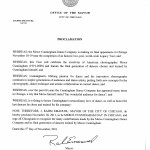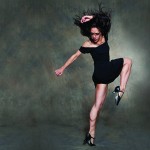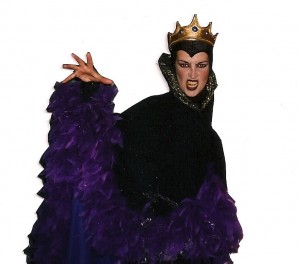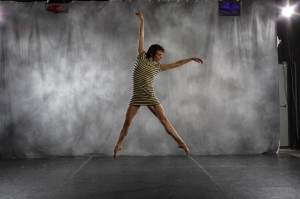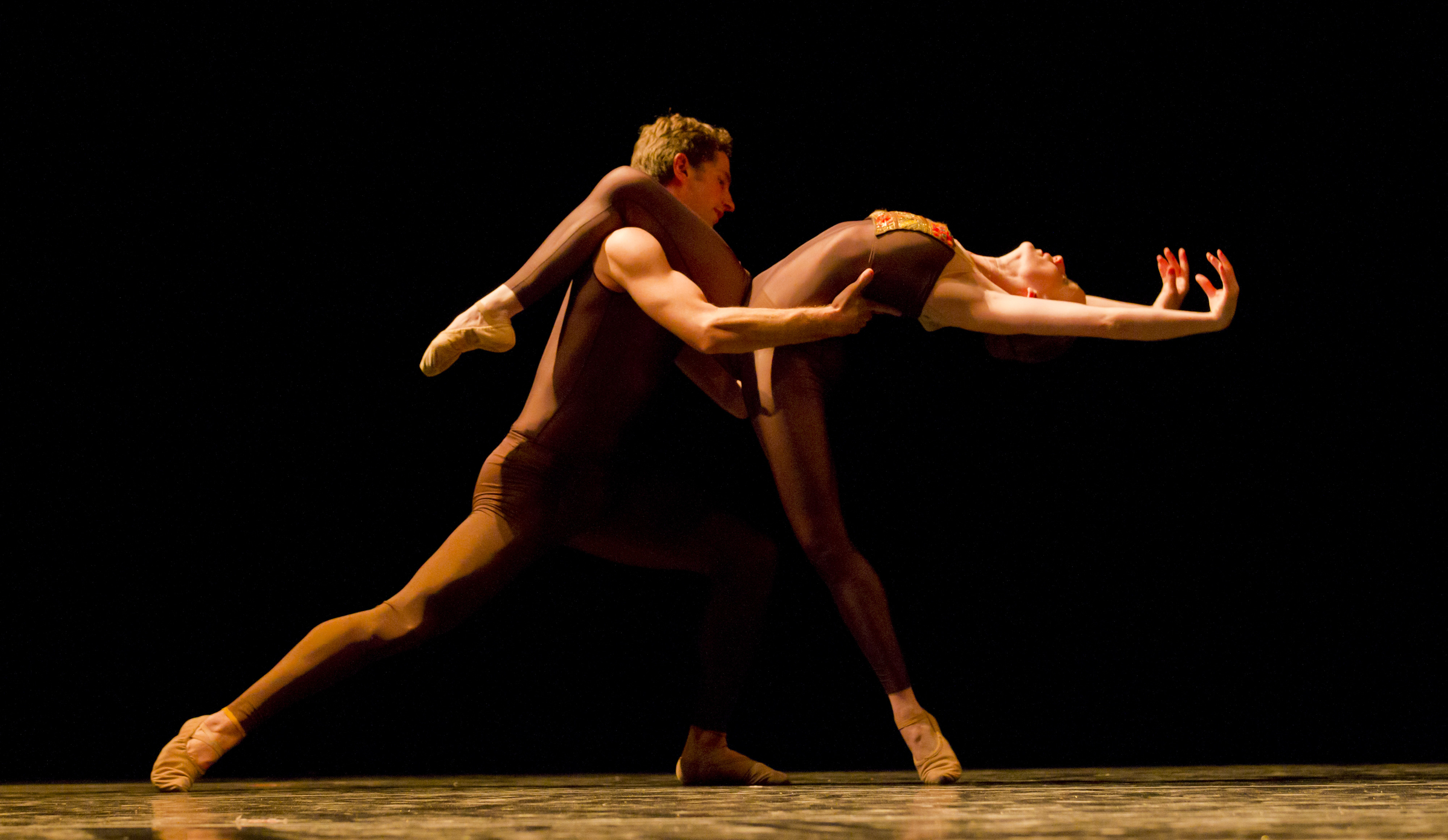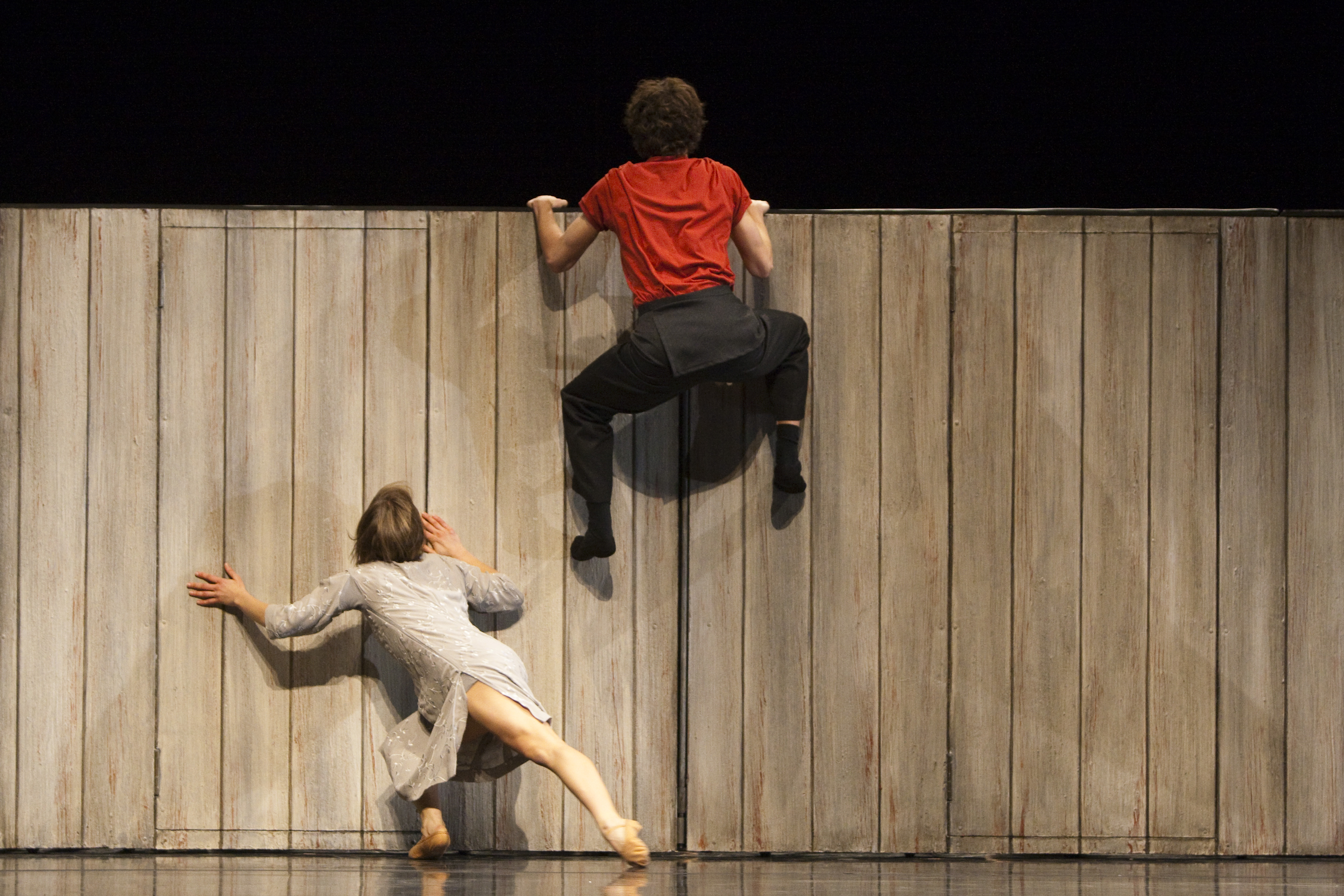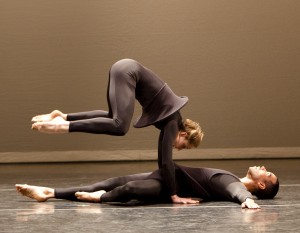
MCDC dancers Rashaun Mitchell & Andrea Webber in "Antic Meet". Photo by Yi-Chun Wu.
This weekend, Merce Cunningham Dance Company (MCDC) comes to Chicago. The two shows, co-presented by the Dance Center at Columbia College and the Harris Theater, mark the second to last stop on the company’s two-year Legacy Tour performing works from Cunningham’s 70-year career. Bonnie Brooks, former chair and current faculty member (on sabbatical) at Columbia College’s Dance Department, has been traveling with the company and will be documenting the company’s experience for the Legacy Plan. Her background and extensive knowledge of his work make her the perfect person for the job. I spoke with Brooks via phone last week about the tour, his legacy and the upcoming performances.
How did you get involved with the Legacy Tour?
I have a long history with Merce and the company. I first met Merce in the 1980s when I was working with the National Endowment for the Arts. I’ve kept up with the company in various ways over the years. When I came to Chicago and we began to present them, that sort of furthered the relationship and I started writing and lecturing on Merce’s work and they started inviting me to go to different engagements with them and do pre-performance talks, interview Merce, help out with various things. After Merce died (2009) and they determined they were going to go on the Legacy Tour, they realized part of what they needed to do was document it, document the whole story of the Legacy Plan. They felt that because of my history with the company, my friendship with Merce and something of the distance that I had because I wasn’t immediately employed by the company, that I would be a good choice to do that. So they invited me to join.
Is this directly related to why you took a sabbatical? Did you take time off so you could be on the tour?
No. Actually, that was another piece of the story that was one of those marvelous coincidences in life. I made the decision in 2008 when I renewed my contract to chair the dept at the Dance Center, that was going to be my final three years as chair. At that time Merce was still living and there was no influence at all between my decision and what has happened. Since then, the college decided to give me a year-long sabbatical when I stepped down and that very neatly coincided with when the company wanted me to start traveling with them on a regular basis. It’s one of those wonderful accidents.
What exactly are you doing on the tour?
It varies from engagement to engagement. Sometimes they ask me to pre or post-performance talks or introduce open rehearsals, things like that. Sometimes I’m just there to observe what’s happening. I’ve taken pictures. It really depends on what the presenter has asked, what residency activities have been put together. One of the things that has happened as a result of me traveling with them, which I think was an intention on their part, it has given me a chance to get the perspective of many, many people on the Legacy Tour, the Legacy Plan, the kind of radical decision the company has made to close its doors…that’s given me a lot to work with in terms of what I’ll be writing after the tour.
Were you instrumental in getting them here?
Yes. When I was chair of the department, I was very actively involved with the program. We had negotiated that they would come two years ago. We negotiated it before Merce died that they would come and do events at our theater, previous to that we’d always presented them at the Harris Theater…and then Merce died. They began to book the Legacy Tour and I said we have to bring them back one more time. We were going to have them in November, but decided to have them in the second part of the tour, which is wonderful because they’re very near the end of the almost 40-city, two-year tour.
Now that it’s so close the end of the tour, are people getting more emotional?
Yes. It’s becoming much more real to everyone now that we’re close to the end. I think the place that hit us the most vividly was in London. We were in London about a month ago and the final night, I think everybody in the entire theater – in the audience and on stage – was in tears. We realized this was the last appearance in a city that historically has been very hospitable to Merce’s work. The audience was on its feet shouting “thank you!” It just really hit us that we wouldn’t be back again, at least not as the Merce Cunningham Dance Company. The thing that’s been so profound about this is realizing that this is the final generation of dancers that Merce trained and chose himself. These are the people, in my opinion, that are finishing his long, artistic project. There’s such a poignancy and a beauty to that and I think in London we realized, we’re beyond seeing the work, this is now really the goodbyes.
Since you’re so familiar with his work, can you tell me about the pieces that are going to be presented here in Chicago?
Friday night, we’re doing a repertory evening…a piece called “Squaregame”, “Quartet”, which has five people in it, and then “Antic Meet”, which is a piece from 1958 that Merce made. “Squaregame” is a very playful piece. There are beautiful sections, but it’s almost like you’re on a playground with mischievous children in terms of the fun that occurs and there are big duffel bags on the stage that they throw around and hide behind. It’s really a delightful piece. Then you go to a completely different end of the spectrum with “Quartet”, which is kind of dark and moody. There’s a male part in it that Merce danced originally and two other males and two females. You’re watching the interaction between this group of dancers and this individual character. It’s very lyrical, but in a very dark way, but it’s beautiful. It’s easy, because of the complexities of Merce’s work, its easy to lose the fact that there is enormous beauty in it. And this is one of his more beautiful pieces, in my opinion. The last piece on the rep is “Antic Meet”, sort of a spoof. In it’s eight different sections. There’s a central character. It’s an anomaly in Merce’s body of work in some ways because there is some acting involved. There are references to Vaudeville, to every day life, to tap, to ballet…there are fairly clear references to his period with Martha Graham.
The second evening is one of my very favorites of Merce’s piece. It’s called Roaratorio. It’s an hour-long work that was originally envisioned by John Cage. Cage created a soundscape that was an homage to James Joyce and his final works…Finnigan’s Wake. One of the things Cage did was go to Ireland and sample sounds from places that were referenced in Finnigan’s Wake. So this was a rare occasion where the sound information pre-dated everything else. John had hoped Merce would eventually make some kind of dance using the score. For several years, Merce didn’t think that was possible. He has built in a number of what appear to be Irish jigs. There are a lot of relational information in it, couples and groups relating to one another. He described one as a group or family traveling from one place to another, which is what they do if you watch the full arc of the piece. I think it’s the best example of Merce’s sheer love for dancing. It ‘s a joy to watch from start to finish.
In your mind, what is it or was it about Merce and his work that made him such an icon?
I think that Merce represents and, in fact, literally is the single most turning point in 20th century modern dance. Merce took a lot of the existing conventions that were handed to him in both the modern and ballet world…and because of the combination of existing things that he did, he stayed in modern dance, he stayed in a concert dance format, he put together an ensemble of dancers, he trained them and he worked with them consistently for many decades…those are all sort of conventions. In terms of the content of the work itself, he just broke so many rules. He advanced narratives, he separated the dance from the music, he choreographed in silence, he and John (Cage) created this whole new approach to put dance, music and visual information together in a performance context. He just did so much that was inconoclastic. He turned the use of space on its head. He created an egalitarian circumstance for dancers instead of a hierarchy of some kind where there were special people and less special people and the back up people. The list goes on and on. The bottom line is that Merce set a whole new direction of what was possible. It was through him and the gateway of his work that the whole postmodern movement came through. If there hadn’t been a Merce, I don’t know what postmoderism in dance would’ve been. He opened a whole new direction for dance.
Merce Cunningham Dance Company – The Legacy Tour
November 18 & 19, Harris Theater, 205 E. Randolph, 312.334.7777
Tickets start at $25


